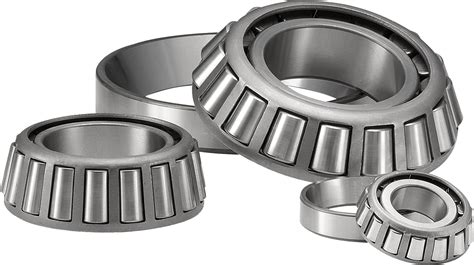Axles with Bearings: A Comprehensive Guide to Design, Selection, and Maintenance
Axles with bearings are essential components in various mechanical systems, from automobiles to industrial machinery. They enable efficient transmission of power and support rotating parts, reducing friction and wear. This comprehensive guide delves into the intricacies of axles with bearings, covering their design, selection, and maintenance.
Design Considerations
Axle Materials and Properties
Axles are typically made of high-strength materials such as steel alloys or forged iron. The material selection depends on factors such as the load capacity, fatigue resistance, and operating environment. Steel axles can withstand high loads, while forged iron axles offer better fatigue resistance.
Bearing Selection
The choice of bearings depends on the operating conditions, such as load, speed, and operating temperature. Common types of bearings used in axle assemblies include:

-
Tapered roller bearings: Handle heavy radial and axial loads
-
Ball bearings: Provide low friction and high speed capabilities
-
Needle bearings: Designed for high radial loads and limited axial loads
Housing and Seals
The axle housing protects the bearings from external contaminants and provides lubrication. Seals prevent oil leakage and contamination ingress. Common types of seals include:
-
Lip seals: Contact seals that prevent fluid leakage by preventing fluid from passing the sealing lip
-
O-rings: Elastic seals that provide static sealing
-
Mechanical seals: Combination of stationary and rotating components that provide dynamic sealing
Selection Guide
Load Analysis
The load capacity of the axle assembly is critical in bearing selection. It includes both radial and axial loads that the bearings will encounter during operation. Static loads, such as the weight of the mounted equipment, and dynamic loads, such as shock or vibration, should be considered.
Operating Conditions
The operating temperature, speed, and environment all affect the selection of bearings. High temperatures can reduce bearing life, while high speeds require bearings with higher limiting speeds. Contaminants and moisture can also impact bearing selection, requiring specialized seals or corrosion-resistant materials.


Maintenance Considerations
Lubrication
Proper lubrication is crucial for extending the lifespan of bearings. The type of lubricant, viscosity, and frequency of lubrication depend on the operating conditions. Grease lubrication is common for low-speed applications, while oil lubrication is preferred for high-speed applications.
Inspection and Monitoring
Regular inspection and monitoring can identify potential bearing issues early on, preventing catastrophic failures. Visual inspections, vibration analysis, and temperature monitoring are common methods used to assess bearing health.
Benefits of Axles with Bearings
- Reduced friction and wear, leading to improved efficiency and extended component life
- Increased load capacity, enabling the handling of heavy loads
- Smooth and quiet operation, minimizing noise and vibration
- Compact design, allowing for space optimization in various applications
Comparisons: Pros and Cons
Pros:
- High load capacity
- Reduced friction and wear
- Improved efficiency
- Extended component life
- Smooth and quiet operation
Cons:
- Can be more expensive than plain bearings
- Requires regular lubrication and maintenance
- Can be susceptible to contamination and damage if not properly protected
FAQs
Q1: What is the difference between an axle and a bearing?
An axle is a rotating shaft that supports and transmits power to rotating components, while a bearing is a component that enables the axle to rotate smoothly and reduces friction.
Q2: What is the purpose of an axle housing?
The axle housing provides protection to the bearings from external contaminants and provides a lubricant reservoir.

Q3: How often should bearings be lubricated?
The lubrication frequency depends on the operating conditions. High-speed and high-load applications require more frequent lubrication. Refer to the manufacturer's guidelines for specific recommendations.
Q4: What are the signs of worn bearings?
Excessive noise, vibration, and heat buildup can indicate worn bearings. Decreased efficiency and power transmission issues are also potential indicators.
Q5: What is the life expectancy of an axle bearing?
Bearing life expectancy is influenced by factors such as load, speed, lubrication, and operating environment. Proper maintenance and operating conditions can extend bearing life significantly.
Q6: How much does an axle with bearings cost?
The cost of an axle with bearings varies depending on the size, load capacity, and type of bearing. Costs can range from a few hundred dollars to several thousand dollars.
Interesting Stories
Story 1:
A factory's conveyor system experienced frequent breakdowns due to worn bearings. After installing axles with self-lubricating bearings, the system ran smoothly with minimal maintenance, saving significant downtime and repair costs.
Story 2:
A transportation company had issues with premature bearing failures in their truck axles. By upgrading to bearings with higher load capacity and improved sealing, they extended bearing life and reduced maintenance intervals, resulting in decreased downtime and increased vehicle efficiency.
Story 3:
A construction site faced challenges with heavy vibration and shock loads on their equipment axles. By implementing axles with tapered roller bearings, they improved load handling capacity, reduced vibration, and maintained equipment integrity in demanding work conditions.
Conclusion
Axles with bearings play a vital role in various mechanical systems, enabling efficient power transmission and reduced friction. By understanding design considerations, selecting the appropriate components, and implementing proper maintenance practices, organizations can maximize the performance and lifespan of their equipment. The benefits of axles with bearings, including increased load capacity, improved efficiency, and reduced downtime, make them an essential component in a wide range of industrial and automotive applications.

